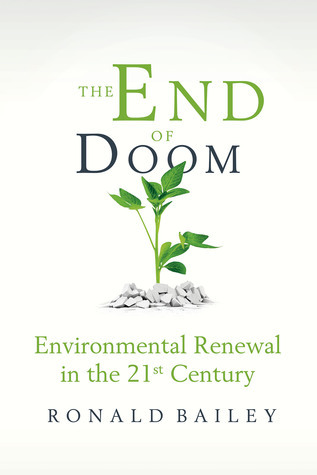What do you think?
Rate this book


368 pages, Hardcover
First published April 28, 2015

[Imported automatically from my blog. Some formatting there may not have translated here.]
Despite my expectations this was not a Fantastic Four comic book recounting their final defeat of Dr. Doom. Instead the subtitle is "Environmental Renewal in the Twenty-first Century". It is written by the estimable science correspondent for Reason magazine, Ronald Bailey. And thanks to the stunningly good efforts of the Interlibrary Loan department of the University Near Here, who worked a copy out of the clutches of Northeastern University.
Bailey's book is an antidote to the various predictions of near-term ecological disaster. Those have been with us since Malthus, I guess, but Bailey is more concerned with more recent Jeremiahs: e.g., Rachel Carson, Paul Ehrlich, the Club of Rome, Bill McKibben, etc. Wolf-crying continues to be a popular and profitable undertaking to this day.
Most chapters deal with a subcategory of possibile global disaster: overpopulation; resource exhaustion; genetic manipulation; epidemic levels of cancer; anthropogenic climate change; mass species extinction. And there's an excellent chapter on the "precautionary principle" used by those who would thwart technological progress; its clever title: "Never Do Anything For the First Time".
Unlike a number of folks on this side of the libertarian/conservative divide, Bailey has been persuaded to believe in the reality of anthropogenic global warming. His chapter on the topic, however, gives plenty of respect to the skeptics, and no support at all to the notion that it's an excuse to hand worldwide governments extraordinary new powers of regulation, subsidy, taxation, and mandate. He argues, convincingly, that a lot of good would be done by elimination of existing fossil fuel subsidies without making the same subsidization mistake for "renewables".
If I had to quibble: the book at times seems to be stitched together from old Reason columns and various op-eds. Which is fine, but I'd welcome just reprinting those works, updating as necessary to reflect recent events.
Bailey's prose is OK, but he sometimes makes regrettable choices in what to include in the main text of the book. Endless studies are summarized, and sometimes no detail seems too small to omit. ("In Cartagena, Columbia, privatization boosted the number of people receiving piped water by 27 percent.")